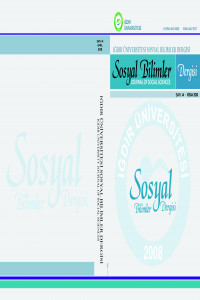Abstract
Buddhist sanat eserlerinin ilk izlerine MÖ III. yüzyılda rastlanılır. Bu dönem Gandhara ekolünün etkisi altındadır. MS II. yüzyıla gelindiğinde, dönemin siyasi güçlerinin de desteğiyle, zirveye ulaştığı anlaşılmaktadır. Bu dönem itibariyle, Buddhist ikonografi büyük bir önem kazanmış ve çok sayıda Buddha heykeli yapılmıştır. Bu heykeller görünüşleri itibariyle, antik Yunan heykellerinin izlerini taşışalar da, konularını Hint’ten çoğunlukla da Buddhizm’den almışlardır. Gelişim süreçleri açısından Gandhara ekolünün çağdaşı olarak bilinen ve tıpkı Gandhara gibi, MÖ II.-III. yüzyıllar itibariyle var olan Mathura sanatı ise Hint’e özgü, yerel tarzı ile dikkat çekmektedir. Önceleri daha çok Cain ve Hindu kültürden beslendiği anlaşılan Mathura sanatının, MS II.- III. yüzyıla gelindiğinde, Gandhara ile birlikte, etkisini Buddhist eserler üzerinde göstermeye başladığı bilinmektedir. Biz de bu çalışmayla, sanatsal gelenekleri ve üslupları açısından farklılıklar gösterseler de, yaklaşık sekiz, dokuz yüzyıllık bir süreçte, Buddha heykellerine can veren Gandhara ve Mathura sanat ekollerinin, geleneksel Hint sanatına olan izlerini yansıtmaya çalışılmıştır.
References
- Bazin, Germain. Sanat Tarihi Sanatın İlk Örneklerinden Günümüze, İstanbul: Kabalcı Yayıncılık, 2015.
- Coomaraswamy, A.K. History of Indian and Indonesian Art, Mon- tana: Kessinger Publishing, 2003, s. 32.
- Craven, Roy C. Indian Art A Concise History, London: Thames and Hudson Ltd. 1987.
- Goetz, Hermann. The Art of India Five Thousand Years of Indian Art, New York: Greystone Press, 1964.
- Huntington, Susan L. The Art of Ancient India Budist, Hindui Jain, Tokyo: Weatherhill Inc., 1985.
- Kaya, Korhan. Hint Mitolojisi Sözlüğü, “Yaksha”, Ankara: İmge Kitabevi, 2003.
- Kaya, Korhan. Budizm Sözlüğü, “Bodhisattva”,“Hīnāyana”, “Mahāyāna” Ankara: Doğu- Batı Yayınları, 2017.
- Kumar, B. The Early Kushanas (A History of the Rise and Progress of Kushana Power under the Early Rulers from Kujula Kadphises to Vasudeva), New Delhi: Sterling Publis- hers, 1973.
- Kurt, Behrendt. The Art of Gandhara, New Haven: Yale Univer- sity Press, 2007.
- ………………. “Relic Shrines of Gandhara: A Reinterpretation of the Archaeological Evidence”, Gandharan Buddhism, Archaeology, Art, Texts, ed. Pia Brancaccio & Kurt Bhrendt, Toronto: UBC Press, 2006.
- Percy Brown, Indian Architecture (Budist And Hindu Period, Worcestershire: Read Books ltd. 2013.
- Pugachenkova, G. A., Dar, S. R., Sharma R. C. “Kushan Art” History of Humanity, 3, Paris: Unesco Publis- hing, 1996,
- Ramesh Sharma. “Kuşan Sanatı ve Medeniyeti”, Türkler Ansiklo- pedisi, 2, Ankara: Yeni Türkiye Yayınları, 2002.
- Singh, Upinder. “Cults and Shrines in Early Historical Mathura (c. 200 BC-AD 200)” World Archaeology, 36, 2004.
- Smith, Vincent A. A History of Fine Art in India & Ceylon, Oxford: The Clarendon Press, 1930.
- Tömör, Edith. A History of Fine Arts in India, Hyderabad: Orient Longman, 1992.
Abstract
First traces of Buddhist art works were seen in the third century B.C. This period is under the influence of the Gandhara cult. It is understood that when it came to the second centuries, it reached its summit with the support of the political forces of the period. As of this period, Buddhist iconography gained a great importance and many Buddha sculptures were made. Although these sculptures traced the sculptures of ancient Greek sculptures by their appearance, they took their subjects mostly from India and Buddhism. In terms of developmental processes, it is known as the contemporary of the ecology, just like Gandhara existing during third and second centuries BC, Mathura art is notable for its indigenous, local style. The Mathura art, which seems to be predominantly fed from Cain and Hindu culture at the beginning, when it comes to the third and second century, within the influence of Gandhara, it is known that it began to show its influence on Buddhist works. In this work, although they differed in terms of their artistic traditions and styles, in about eight or nine hundred years, the Gandhara and Mathura art cults, which gave birth to Buddha sculptures, were tried to reflect the traces on the traditional Indian art.
References
- Bazin, Germain. Sanat Tarihi Sanatın İlk Örneklerinden Günümüze, İstanbul: Kabalcı Yayıncılık, 2015.
- Coomaraswamy, A.K. History of Indian and Indonesian Art, Mon- tana: Kessinger Publishing, 2003, s. 32.
- Craven, Roy C. Indian Art A Concise History, London: Thames and Hudson Ltd. 1987.
- Goetz, Hermann. The Art of India Five Thousand Years of Indian Art, New York: Greystone Press, 1964.
- Huntington, Susan L. The Art of Ancient India Budist, Hindui Jain, Tokyo: Weatherhill Inc., 1985.
- Kaya, Korhan. Hint Mitolojisi Sözlüğü, “Yaksha”, Ankara: İmge Kitabevi, 2003.
- Kaya, Korhan. Budizm Sözlüğü, “Bodhisattva”,“Hīnāyana”, “Mahāyāna” Ankara: Doğu- Batı Yayınları, 2017.
- Kumar, B. The Early Kushanas (A History of the Rise and Progress of Kushana Power under the Early Rulers from Kujula Kadphises to Vasudeva), New Delhi: Sterling Publis- hers, 1973.
- Kurt, Behrendt. The Art of Gandhara, New Haven: Yale Univer- sity Press, 2007.
- ………………. “Relic Shrines of Gandhara: A Reinterpretation of the Archaeological Evidence”, Gandharan Buddhism, Archaeology, Art, Texts, ed. Pia Brancaccio & Kurt Bhrendt, Toronto: UBC Press, 2006.
- Percy Brown, Indian Architecture (Budist And Hindu Period, Worcestershire: Read Books ltd. 2013.
- Pugachenkova, G. A., Dar, S. R., Sharma R. C. “Kushan Art” History of Humanity, 3, Paris: Unesco Publis- hing, 1996,
- Ramesh Sharma. “Kuşan Sanatı ve Medeniyeti”, Türkler Ansiklo- pedisi, 2, Ankara: Yeni Türkiye Yayınları, 2002.
- Singh, Upinder. “Cults and Shrines in Early Historical Mathura (c. 200 BC-AD 200)” World Archaeology, 36, 2004.
- Smith, Vincent A. A History of Fine Art in India & Ceylon, Oxford: The Clarendon Press, 1930.
- Tömör, Edith. A History of Fine Arts in India, Hyderabad: Orient Longman, 1992.
Details
| Primary Language | Turkish |
|---|---|
| Journal Section | Research Article |
| Authors | |
| Publication Date | April 1, 2018 |
| Published in Issue | Year 2018 Issue: 14 |

